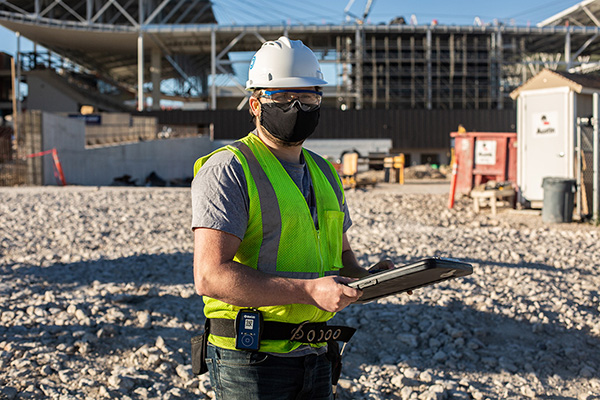Amid the COVID-19 pandemic, manufacturing facilities have upped their game to navigate new and evolving workplace safety requirements.
By Nathan Dunn, CEO, BlueCats
Amid the COVID-19 pandemic, manufacturing facilities have upped their game to navigate new and evolving workplace safety requirements. Keeping the doors open and mitigating downtime means keeping employees healthy.
While mask-wearing and increased handwashing are simple to implement, the critical work of post outbreak contact tracing — the process of identifying anyone who was in close contact with an infected individual — is more complex. However, trusted technologies are making it easier to track and identify infected workers and staff, which was traditionally laborious and managed by external health departments. The process often led employers to send large groups — or even all — of employees home to quarantine, a costly prospect for everyone.
New solutions, such as wireless technology via wearables, expedites the tracing process and ensures information accuracy. Using wireless technology helps reduce the economic burden of a potential shutdown.
While the increasing rollout of the COVID-19 vaccine is positive news for employers and employees, polling indicates not everyone can or will receive the vaccine. As a result, organizations must turn to technology to help them maintain a safe work environment.

McKinsey recently noted that “jobs in work arenas with higher levels of physical proximity are likely to see greater transformation after the pandemic.” While some companies — such as retail stores, warehouses and manufacturing plants — may plan to deploy artificial intelligence or other technology to reduce the number of workers at a location, that approach is not feasible for all companies.
Additionally, relying on a vaccine is not a viable solution. Recent polling from Morning Consult revealed approximately 56% of employees plan to get the COVID-19 vaccine.
The numbers vary by industry — from less than half (47%) of food and beverage workers to more than three-quarters (77%) of higher education workers. About 53% of manufacturing workers plan to receive the vaccine.
There are two main approaches to a contact tracing system architecture: implementing a Real-Time Location System (RTLS) or calculating the device-to-device distance.
Several wireless location technology options within those frameworks capture location data for tracing: Bluetooth LE, Wi-Fi, Global Positioning System (GPS) and Ultra-Wideband (UWB). Of the options, it’s UWB that offers the most promise.
Consumers know UWB technology as “that new chip” in a smartphone. However, it has been available for unlicensed commercial use in the United States for nearly two decades and used for real-time location products for over a decade.
UWB captures accurate measurements of time and distance for social distancing purposes — precise to within a centimeter — and stores it securely to maintain the privacy of users. And, those companies with 300 employees or fewer can use their second round of Payroll Protection Program (PPP) funding to purchase COVID-related safety gear for workers, including UWB contact tracing solutions.
To be successful in the emerging workplace paradigm, employers must know which people and assets are on-site at any given time. Wearable devices that provide contact tracing work both indoors and outdoors, making them an ideal component of any manufacturing business.
In the current environment, manufacturing facilities need a solution that is easy to use and reliable — one that assuages any concerns and bolsters their confidence level to return to the office, making UWB the best technology for capturing data for contact tracing.
Tracing enables organizations to track employees and visitors in real-time. With the right solution, it visualizes and collects all interactions in the event of a outbreak.
Should an employee tests positive for COVID-19, companies can begin notifying and quarantining those who might have come into contact with the infected employee. While bothersome and potentially disruptive to operations, quarantining exposed employees impacts the bottom line less than shutting down an entire facility, which is the likely outcome of an outbreak at a facility without contact tracing in place.
Companies that deploy contact tracing should confirm that the solution they select stores information in a privacy-protected database.
No one anticipated the pandemic, and it has presented a unique set of challenges for businesses today. However, we have an opportunity to move forward in a way that also helps us prepare for the next challenge.
And it all comes down to deploying the right technology to help mitigate the adverse effects of what we are experiencing now and what the future may hold for us.

Nathan Dunn is the CEO at BlueCats, a revolutionary Real Time Location System (RTLS) provider with foundational influence on Ultra-Wide Band (UWB) and Bluetooth solutions. He has more than twenty years of technology and RTLS experience spanning industries such as construction, retail, manufacturing and Food & Beverage. His passion, and the company’s obsession, is to remove complication and technical barriers from RTLS systems at scale, bringing real time Digital Awareness to every industry on the planet.
www.bluecats.com
In this episode, I sat down with Beejan Giga, Director | Partner and Caleb Emerson, Senior Results Manager at Carpedia International. We discussed the insights behind their recent Industry Today article, “Thinking Three Moves Ahead” and together we explored how manufacturers can plan more strategically, align with their suppliers, and build the operational discipline needed to support intentional, sustainable growth. It was a conversation packed with practical perspectives on navigating a fast-changing industry landscape.